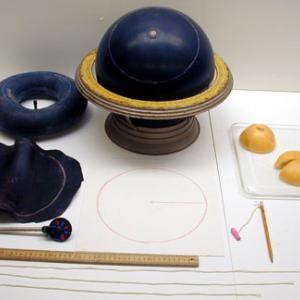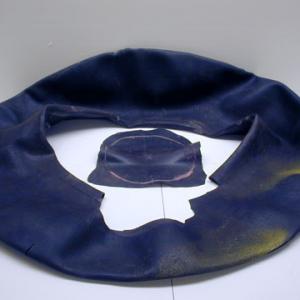College of Liberal Arts & Sciences
8C20.35 - Non-Euclidean Geometry
In the first part of this experiment take the compass and set it to the proper diameter using the compass standard. Now take a piece of string and place it on the circle drawn on the standard and cut it so that the ends meet. This string when measured with the pulley measuring tool should be 5 and 3/16 revolutions long. Now use the compass on the chalk globe to mark a circle, and then cut a string to fit this circle. Even though made with the same diameter compass this string should only measure 4 and 12/16 revolutions long. Now do the same procedure on the piece of inner tube cut from the inside radius of the tube. This string should only measure 4 and 5/16 revolutions long. This demonstrates that even though drawn with the same compass radius the total circumference distance will be different depending on whether the surface is flat or spherical, and whether the spherical surface is an inner or outer radius. Take the inner tube piece and one/half of the grapefruit and try to flatten them. This shows that a spherical surface cannot be flattened unless the object is torn or stretched in some manner.
- Monika Wood, Warren Smith, and Matthew Jackson, "Curvature of spacetime: A Simple Student Activity", TPT, Vol. 54, #9, Dec. 2016, p. 572.
- Mason Mabin, Maria Becker, and Herman Batelaan, "Measuring Intrinsic Curvature of Space with Electromagnetism", TPT, Vol. 54, #9, Oct. 2016, p. 416.
- Charles A. Eckroth, "Model of a Negatively Curved Two-Dimensional Space", TPT, Vol. 33, #5, May 1995, p. 286.
- Charles A. Eckroth, "Counting Distant Radio Sources to Determine the Overall Curvature of Space", TPT, Vol. 30, #2, Feb. 1992, p. 92.
- P. K. MacKeown, "Gravity is Geometry", TPT, Vol. 22, #9, Dec. 1984, p. 557.
- Joseph A. Keane, "A Can of Negative Space", TPT, Vol. 16, #1, Jan. 1978, p. 8.
- Rev. Myron Effing, O. S. C., "Squashed Space: An Activity Concerning General Relativity", TPT, Vol. 15, #5, May 1977, p. 298.
- Hugo Caerols, "Using Smartphone Photographs of the Moon to Acquaint Students with non-Euclidean Geometry", AJP, Vol. 89, #12, Dec. 2021, p. 1079.
- Joan Centrella, "Resource Letter: GrW-1: Gravitational Waves", AJP, Vol. 71, #6, June 2003, p. 520.
- Wolfgang Rueckner, Justin Georgi, Douglass Goodale, Daniel Rosenberg, and David Tavilla, "Rotating Saddle Paul Trap", AJP, Vol. 63, #2, Feb. 1995, p. 186.
- Alex Lopatka, "The Behavior of Thin Curved Sheets is Ironed Out", Physics Today, Vol. 75, #11, Nov. 2022, p. 19.
- Richard J. Fitzgerald, "Non-Euclidean Geometry on a Chip", Physics Today, Vol. 72, #8, Aug. 2019, p. 68.
- Glen Van Brummelen, "Trigonometery for the Heavens", Physics Today, Vol. 70, #12, Dec. 2017, p. 70.
- Carl Modes and Mark Warner, "Shape-programmable Materials", Physics Today, Vol. 69, #1, Jan. 2016, p. 32.
- Mark Wilson, "Custom Shapes from Swell Gels", Physics Today, Vol. 56, #5, May 2012, p. 15.
- Rachel Feltman, "What Shape is the Universe?", Popular Science, Vol. 291, Fall 2019, p. 18.
- J. J. Callahan, "#3. The Curvature of Space in a Finite Universe", Scientific American Cosmology +1, Aug. 1976, p. 20. See the Lecture Demo Reference Library in Rm. 58 for this reference.
- Vicki Cobb and Kathy Darling, "The Great Escape", Bet You Can!, p. 107.
- Vicki Cobb and Kathy Darling, "Loose Change", Bet You Can!, p. 105.
- Vicki Cobb and Kathy Darling, "Curses, Coiled Again", Bet You Can't!, p. 70 - 71.
- Vicki Cobb and Kathy Darling, "Clip Joint", Bet You Can't!, p. 68.
- Jim Glenn, "Karl Friedrich Gauss (1777 - 1855)", Scientific Genius: The Twenty Greatest Minds, p. 60 - 64.
Disclaimer: These demonstrations are provided only for illustrative use by persons affiliated with The University of Iowa and only under the direction of a trained instructor or physicist. The University of Iowa is not responsible for demonstrations performed by those using their own equipment or who choose to use this reference material for their own purpose. The demonstrations included here are within the public domain and can be found in materials contained in libraries, bookstores, and through electronic sources. Performing all or any portion of any of these demonstrations, with or without revisions not depicted here entails inherent risks. These risks include, without limitation, bodily injury (and possibly death), including risks to health that may be temporary or permanent and that may exacerbate a pre-existing medical condition; and property loss or damage. Anyone performing any part of these demonstrations, even with revisions, knowingly and voluntarily assumes all risks associated with them.

